The whole main square (Parque Calderon) of Cuenca is lined with stands selling traditional sweets, and a lot of non-traditional sweets. We asked a vendor which were the most traditional, and sampled some fruit-based sugary concoctions, coconut candy, and quesadillas which in this manifestation are sweet turnovers filled with a cheese. All 10 zillion stands seem to offer pretty much the same fare. Everything is displayed open air. We didn’t see any flies buzzing around, but there were a fair number of bees taking advantage of the offerings, so we tried to dig the sweets we purchased out from lower layers. Several vendors had TVs set up. They were watching the news when we saw them, but I’m guessing they may have had something to do with the Copa Americana soccer tournament going on in Chile.
|
Nine weeks after Easter Sunday the Catholic festival of Corpus Cristi (literally translated to Body of Christ) begins. The festival was established by the Catholic Church to celebrate the sacrament of communion, based on Jesus’ sharing of wine and bread with his disciples during the last supper. But the festival as currently celebrated seems to have a pretty loose tie with its origins. Yes, there were a few religious processions and masses related to the celebration, which lasts a week. But the emphasis here seems to be on sweets, fireworks, and other diversions. Some say that the festival has merged with pre-catholic celebrations related to the summer solstice which happens in the same month. We ventured downtown on the next to last night of the festival to check it out. The whole main square (Parque Calderon) of Cuenca is lined with stands selling traditional sweets, and a lot of non-traditional sweets. We asked a vendor which were the most traditional, and sampled some fruit-based sugary concoctions, coconut candy, and quesadillas which in this manifestation are sweet turnovers filled with a cheese. All 10 zillion stands seem to offer pretty much the same fare. Everything is displayed open air. We didn’t see any flies buzzing around, but there were a fair number of bees taking advantage of the offerings, so we tried to dig the sweets we purchased out from lower layers. Several vendors had TVs set up. They were watching the news when we saw them, but I’m guessing they may have had something to do with the Copa Americana soccer tournament going on in Chile. After checking out the sweets we found a cluster of more typical food vendors (meat skewers, the ever present salchipapas, etc.) and game stands that had been set up for the festival. Gabe was very drawn to the games of chance that involved spinning wheels and the lure of doubling or tripling whatever small change one puts on the game board. We found it ironic that a religious festival was his (albeit relatively mild) introduction to gambling. The kids were equally interested in the big target board and dart gun game. We gave in to that one since it seemed like they had an actual chance of winning something. So instead of having their first try at gambling they had their first try at shooting a weapon (again, a relatively low key one). Gabe started out trying to win the $20 bill on the game board but by his third try of three switched targets, and both kids were happy with the candy they won. The highlight of the night for me were the fireworks. Over the course of the week different organizations and municipalities in the area donate firework towers to be lit. Some nights there are a few, and others many. These towers wouldn’t be allowed in liability-focused US, but they are really fun to watch, especially because one can get pretty close. First the lower level burns, then the next, then the next, until the dramatic explosion of the top whirling level. I didn’t get very good pictures of the fireworks, but here is a picture of the tower that bursts into fireworks on three levels and then shoots fireworks to the sky from the last level. Trust me, it was exciting. And loud. An interesting aspect of the festival that I didn’t expect to see were the protests. Ecuador’s president, Rafael Correa, had announced some new taxes on inheritances just before the festival started, which sparked criticism and protests. Protestors take advantage of the festivals to draw attention to their message, and the ruling party responds with counter protests. So when we first walked up to the main square we found one street chock full protestors. Anti-Correa demonstrators on one side of the street waving the Ecuadoran flag, and pro-government demonstrators on the other side waving flags of the president’s party and other liberal movements. It was interesting to see, and the demonstrators I approached (on the pro side, since that is where we were standing), were happy to pose with their flags.
0 Comments
To Market, To Market…. One of our regular activities in Cuenca, as it would be anywhere, is buying food. While maybe not one of the most glamorous aspects of our life here, I thought it might be interesting to share what the options look like here. I had anticipated that we might make every other day trips to a neighborhood market for our fresh produce. In fact, covered markets are located throughout Cuenca and feature sections where one can buy fresh veggies and fruit, meat, poultry and seafood section, natural remedies (featuring herbs and liquid concoctions) and a cafeteria area where you can be served up a yummy plate of a variety of local dishes. During our first month in Cuenca we had one such market close to our house and went there regularly to buy produce, fruit and grains. However, I am hesitant to buy meat at these markets because it is often displayed open air, and I have no way of identifying a reliable vendor to buy from. These markets also (obviously) don’t carry the comfort foods we were craving from home (peanut butter, spaghetti sauce and American style cereal). Below are pictures of the dry goods and meat sections of one of these city markets. Local and Organic When we moved to our long-term housing I discovered an organic market that operates nearby every Saturday morning. Unlike in the larger markets where vendors sell goods purchased from importers or big growers as well as local items, the vendors at the organic market are all local growers and certified by an organic growers association. Some of the goods they sell are cultivated, but others, like blackberries, tree tomatoes and flowers, are often items they’ve gathered from their own properties. The market starts at 5:00 AM and by 6:30 some of the best local fruit is often gone. So I stick to my week-day wake-up time and usually make it to the market by a little after 6 am. I’m a morning person and kind of enjoy the crack of dawn experience, but I’ve had trouble getting company from family members on a regular basis. Meat, cheese, seafood and fish are also available at the organic market, although I don’t buy them there. I do buy some tasty local honey and whole wheat bread, and free range eggs. The type of fruit and veggie that are available has been pretty consistent, but every now and then a new fruit will show up that is “in season”. I’m still a bit baffled by how seasons work here, but it is fun to try something new. The market vendors have been very patient with my questions about what things are and how to prepare them. The best reward for my early bird activity are the tortillas de choclo, a kind of fresh corn pancake, that I pick up once I’m done shopping. I sometimes sit and enjoy them with a cup of over-sweetened coffee right at the market. Comforts from Home Cuenca has several American-style supermarket chains, Supermaxi and Coral. Coral is actually more like a Walmart- combining a big grocery store with home goods, hardware, clothes, office supplies, etc. Coral may have the lowest prices but it is so crowded and chaotic that it usually gives me a headache. It also requires that every single produce item be bagged separately and weighted in the produce section. I find it hard to stomach using all that plastic. So Coral is our go-to store only when I’m needing some household staple or last minute school supply that we don’t know where else to find. Usually our weekends include a trip to Supermaxi. When I was first thinking of this post I thought the only unique thing about Supermaxi, compared to US markets, is that it is quite a bit smaller in size, and they require you to check backpacks and large bags by the door when entering the store. But as I took these pictures for the blog I realized that there are significant differences in the offerings. The egg section includes quail eggs, and eggs are not refrigerated. The meat coolers have a big organ section. The milk is boxed, not fresh. The grain section includes lots of grains used for traditional grain-based drinks. And of course the produce and fruit are different, with a lot more tropical fruit available. Another difference is that the grocery bagger will take your groceries to a taxi stand and flag down a taxi for you. In the Neighborhood Even though we’ve stuck to a US- style once a week shopping model for most things, we take full advantage of local mom and pop stores for anything we need in-between times. We can walk a block away to a store that has any last minute thing we need. These little neighborhood stores usually have a grate you can’t get by, and the owners live above the store, or in another part of the first level. Convenient so they can leave the store open but not have to attend it every second- just ring the bell or call out for service. The bigger store by us has eggs, the most common fruits and veggies, dry goods, butter, small quantities of meats, toys, basic school supplies, laundry detergent, snack food etc. It also has an extensive candy counter with 5 and 10 cent options, which has allowed the kids to indulge their sweet tooth tendencies and practice their Spanish. This is the aspect of our local shopping I think I will miss the most (well, maybe after the tortillas de choclo): the ability to walk 2 minutes for an essential item, or to send my very willing 10 year old to the corner for eggs. 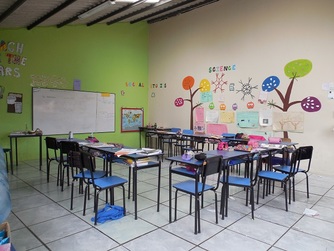 A few weeks ago I posted about Doug an my experience, as parents, navigating the world of elementary school. In this post Lucia and Gabe provide their perspective, in interview format. . Lucia’s answers are in orange, and Gabe’s in green. No editing or elaboration from the intervfiewer What words would you use to describe your school in Ecuador? Understanding/supportive - the teachers are helpful Fun - the teachers like to play games that help learning; there is lots of recess and the kids are friendl Active - Everyone is always doing something, you aren’t just sitting around. Active (people are always paying, working, eating), welcoming, How do you feel about wearing a uniform to school? It’s okay. I like the color of the uniform, but it is hard to wear things that you really like. Both uniforms get a little hot, especially the sweat suit. Most people end up taking off their sweaters by midday. I think it is sort of cool because it is easier to put it on in the morning and I like the colors. What is one aspect of your Ecuadoran school that you wish you could transfer to your school in the US? That everybody is friends with everybody and the classes are rarely disruptive. That it is trilingual – we get to learn French as well as Spanish and English To have a wooded area like we have here. Sometimes we have gym there, or we look for different things for a class. What is one aspect of your school in the US that you wish could be part of your school here? The nice garden and the green house made out of bottles. Air conditioning and heating. Maybe some hallways in the main school so you don’t have to be on slippery ground or get wet when it rains. Gabe: After school homework club. I like being with my classmates and it a good time to get homework done. What is your favorite subject in school here? Spanish language and literature. It’s fun, we do poems and it is not too hard but is challenging, and something I enjoy. English social studies : It is interesting and since we’re doing world history I can learn a lot of things that are important in the US also Math in both Spanish and English, and Science in English. In math I get to do multiplication. In Science we are learning about the organs. How do you like riding the bus to school? I like it, but it would be nice if the seatbelts worked better and were easy to adjust. The drivers are safe, and the ride is short. It is fun, and a good opportunity to talk with friends. And if you bring your Pokemon cards you can trade them on the bus. How do you like the school lunches? School lunches are good. They might not always be the healthiest, and they aren’t always things I like, but I can usually eat most of them. It is nice to be able to try the traditional foods and the lunch ladies make very good food. Some of them I like and some of them I don’t, but it is a good experience to have some of the local foods. One of my favorite local meals is llapingachos. I don’t like the humitas. What do you think about specials here? Art is fun. We can usually be creative, we don’t have to copy a painting that someone else already did. We can make our own version or dream up something. In Gym we play plenty of games. The teacher is very nice. Corporal Expression is fun. We are doing exercises like push-ups, jumping jacks and running or doing relays. In Music we learn a lot and its nice for me because I know a little bit of music, and it is nice to be able to know the Spanish names and still understand. I like that gym is outside everyday. There is a LOT of running around, more than at home. In a different culture you get to learn about different artists, and different ways of painting things. Anything you’ve noticed that is really different? The teachers expect you to pass exams, but there is always time to catch up later. For example, one of my classmates tripped while she was going down the stairs, fainted and hurt her wrist badly so couldn’t write for a week. The students are funny but they pay attention in class and they try their best. That they sing the national anthem in a group with the whole school every Monday morning. The school is totally different. Each classroom has its own door facing the outdoor walkways. What about homework? The homework level is good. It isn’t too hard, and not more than two pages per subject at a time, and usually for the next day or the day after that. It’s different because they give a bigger quantity sometimes. How do you think your Spanish ability has changed? Being immersed in it for more than just an hour at a time is much better and I’ve improved a lot. I’ve expanded my vocabulary and now I talk half the time in Spanish and our whole family can understand what I’m saying. I can do a lot more. I can play with my friends better because I can say more. The topic of language comes up a lot in small talk during taxi rides. Taxi drivers are surprised when expats speak more than basic Spanish. Riders can’t help noticing that a lot of taxi drivers mention they’ve spent 6-10 years in the US, but quickly switch back to Spanish after a few cursory phrases in English. This week during the usual conversation about whether Spanish or English is easier to learn (general concensus: English is easier when it comes to verb forms and because there isn’t gender agreement, Spanish easier when it comes to pronunciation rules), the taxi driver asked me which language I think is “better”. After pondering the taxi driver’s question for a bit I responded that it doesn’t make sense to me to think about language in terms of better or worse. Each language, and local variation of a language, reflects culture, beliefs, and preferences of the people who use it. That is what I love about language, and why I have always loved traveling and living in countries where I have more than a rudimentary grasp of the language. It is fascinating to me to learn local expressions and language use. Thus, I thought I’d share some of the unique expressions and words used here in Cuenca. Many of them come from Kichwa (also sometimes written quichua) language, the northern version of the quechua language imposed by the Incas during their rule. Several colleagues of mine, former Peace Corps volunteers in Cuenca, had told me about some Kichwa expressions before I came. I had expected these words to be used occasionally, and mostly by people of indigenous background as an alternative to the Castillian Spanish word. In fact, the Kichwa words are universally preferred, regardless of social class or ethnic background. While people understand the standard Spanish word, they almost always use the Kichwa. Some of my favorites, accompanied by examples: Ñaño/ Ñaño: Brother/Sister. Tomé este foto con me ñaño cuando el vino a visitarnos. I took this photo with my brother when he came to visit. Guagua – baby or child. Los guaguas en mi clase tienen mucha energía. The kids in my class have a lot of energy. Aychaychay- burrrrrr. Aychaychay, ¡qué frio hace! Burrrrr, its cold. This is usually said by someone wrapped in about 5 layers and a scarf, while I’m standing at their side feeling perfectly comfortable in a long sleeve shirt, or a short sleeved shirt and a vest. The temperature varies by only a few degrees here, but Cuencan’s are sensitive to the changes. Chendo – just kidding. No tenemos escuela hoy. Chendo, si tenemos. There’s no school today! Just kidding! ¡Hele! - an expression of surprise. For example, after hearing that our gym teacher isn’t showing up at preschool , ¡Hele! ¿Y ahora que hacemos? What?! And now what do we do? Chuta – darn it. Or shoot. Chuta, se me olvidó hacer la tarea . Shoot, I forgot to do my homework. Cangüil - popcorn. Sirvense cangüil con el locro. Have some popcorn with your potato soup. May seem odd, but its super yummy. And then there are some expressions in regular Spanish that I haven’t heard in other places. Linguists posit that some of them, such as indirect requests and the use of the diminutive, were developed in response to the culture of domination and conquest experienced under the Incans and then the Spanish. Here are a few of my favorites: No más – literally “no more” but translated as go right ahead. So for example, in response a request to squeeze by someone (siga no más), or yes go ahead and have another serving of juice (toma no más) or pick out the peppers you want to buy for $1 (coge no más). I hear this multiple times a day in all kinds of contexts. An example of softening the command with some gentle language.
¡Qué goce! - What fun, or what a delight. Qué goce pasar un día con amigos. What fun to spend a day with friends. De me… literally “give me” but actually please. For example, De me cobrando – Please tell me what I owe. Not gramatically correct, but a softened version of a command, using the reflexive form of the verb dar (to give). Another example, de me haciendo instead of hágame when asking for something to be done. No sea malito – be a sweetheart but literally translated to “don’t be bad”. A way of asking for a favor. For example when asking for exact change: No sea malito, pague con sueltos por favor : Be a sweetie and pay with exact change. When combined with the above phrase… No sea malito, de me abriendo la puerta. Be a dear and open the door for me. Ese/Esa Man – that person/dude. Used for both men and women, and borrowed from English. Usually the expression is used to refer to someone in terms of a specific role they have, rather than the person themselves. For example, “Esa man que vino a entrenarnos” that woman that did the training for us. Or it can be used to someone in the third person with a somewhat negative connotation… like, uh, that politician thinks he is so important. “Ese man se cree tan importante”. Full or “a full” – meaning full or a lot. Yes, borrowed from English, but pronounced like "fuhl". For example: “Estoy full” or I am full after a meal. Also, “tengo full deberes” – I have a lot of homework. ¡Qué iras! – how infuriating! Cancelaron el concierto al último momento – qué iras! How frutstrating that they cancelled the concert at the last minute. ¡Qué gara! Beautuful, excellent, wonderful. Que película tan gara. What a great movie. -ito. Little, tiny. But really a way of softening language. For example the phrase “no sea mailto” mentioned above is very much preferred to “no sea malo”. Lucia has learned to ask for “unita más” or just one little bit more of a treat instead of “uno más”. Almost everything is referred to this way. Niñito, favorcito, minutito,aquicito, etc. Más cuencano que el mote - the Cuencan equivalent of as American as apple pie. Mote is a type of hominy that is served with practically every meal here, especially in the countryside. Often there is a big dish sitting on the table to be nibbled throughout the meal. I’ve heard this phrase used to describe certain kids in the preschool who come from traditional Cuencan families. Some of the phrases I’ve shared in this post Qué gara, Hele, Chendo and más cuencano que el mote) are so specific to Cuenca that they appeared in the introduction of the booklet listing all the events to honor the 458th anniversary of Cuenca’s founding! Clearly the ministry of tourism felt visitors from other parts of Ecuador would need a key to these phrases to understand what they would hear while in Cuenca. We’ve certainly had fun learning these words and phrases and at least a couple have snuck into conversation here in the Faulkner casa. 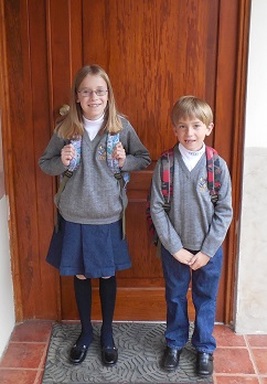 The area of Ecuadoran life we, as a family, have the most frequent contact with is school. While the kids have adapted very well to their new school environment, Doug and I have had many a head-scratching moment trying to figure out what is intended by an assignment, why a particular school supply is required, or what the expectation of parents is in a given situation. Before jumping in I should note that these observations are about our particular experience. I don’t have a good idea of how much they reflect the experience of expat families in other private or public schools, or that of Ecuadoran families. The school Gabe and Lucia attend is not a traditional Ecuadoran school. Rather it is a private bilingual (Spanish/English) school that was developed as an alternative to traditional schools that emphasize rote learning and have huge class sizes. The school is staffed with both Spanish-speaking teachers (primarily Ecuadoran teachers, although there are a few Spaniards also) and English-speaking teachers from England, Canada, and the US. Its “pillars” include the use of Spanish as a native language and English as an instructional language (about 40% of the time); an emphasis on the development of critical thinking and multiple intelligence; educational inclusion and a multicultural focus. Okay, so back to the things that jump out for us about our experience as school parents here. Uniforms Lucia and Gabe wear a dress uniform on Monday and Wednesday and a sports uniform (sweat pants and sweat shirt) on Tuesday and Thursday. On Friday, they can wear what they want. All public and private schools here use uniforms and most have these two iterations. I love the uniform for its simplicity. The kids know what they have to wear when and school clothes shopping is relatively easy. Not that this solves our school morning problems entirely. Somehow we still seem to have a hard time finding all the required pieces on the right day and keeping track of that school sweatshirt! The head scratching part has been the sheer number and variety of uniforms that are required. During the first semester of school all the kids had swimming once a week during the school day and were required to buy the swim suit uniform from the swim school, including the swim cap. This semester they have theater class instead and theater class requires an all-black outfit (leggings or sweat pants and shirt) - no images or designs allowed on the shirt. We enrolled the kids in an outside soccer school and it too requires a uniform. We opted out of having the kids participate in competitions with the soccer school. If they had, that would have required yet another, different soccer uniform. Mensajero. Each kid has a small notebook with a plastic cover that goes from home to school and back again each day. At first I equated it to our Friday folder at home, but the mensajero is more intense. Teachers use it to send home important messages, send field trip permission slips, and to communicate homework assignments. Parents are required to sign each note to indicate it has been received. And it can be used to hold parents accountable. For example, in the purely fictional scenario that a parent read about an assignment and signed the note but the parent and child both spaced the assignment out, the teacher might paste in a new note commenting that the assignment was not completed and referencing the date and content of the first, signed, note. Yikes! Accountability for both the student AND the parents! The mensajero is also a convenient way to ask the teacher for clarification. Our confusion comes with the fact that not all assignments seem to be noted in the mensajero and not all teachers seem to use it the same way. So I’m never quite sure if we have missed something or if we are on track for that week. “Queridos papitos” This is the phrase almost all notes to parents begin with. I was surprised at the informality of the phrase, which translates literally to “my dear little parents”, although the diminutive is meant to be warm rather than demeaning. I’m used to the phrase now, although I usually take a deep breath when I see a note start with “Queridos papitos” because it seems that more times than not it is followed with a request to send some specialized school supply, needed immediately. More about this below. School Supplies Ecuador loves its specialized school papers: poster board, A4 sized cardstock; special drawing paper, etc. The bound notebooks used in classes come in a dizzying array of variations in regard to the number of lines in lined notebooks, graph versus lined paper, etc. The picture below shows the various notebooks arranged by type at our local papeleria. Big end-of-term assignments often require “papel ministro” which translates directly to “ministry paper”. Sort of the Ecuadoran equivalent of blue books, it is an oversized sheet, folded in half. Sometimes lined, sometimes in graph format, sometimes with a special “membrete” or header section. So far I think we’ve needed all the iterations, but never the same twice. Nonetheless, I’ve adopted the strategy of buying at least one extra of whatever is needed in the hopes of eliminating future emergency paper store trips when a special type is needed for the next day’s assignment. Luckily, there are 3 paper stores in our neighborhood and a big one near my work. Even if we don’t understand what the required paper looks like, we can usually get it easily as long as we can tell the store clerk what we need. They must be used to frantic parents coming in just before closing to get some specific form of paper. We are often asked to send in some special item for a class project. Items we’ve been asked to come up with from one day to the next include: grass seed and sand; the advertisement from a magazine; a copy of a movie cover; a plant native to Ecuador; an abacus. You get the idea. And then there are the special materials for creative projects. The most extreme example was right before Christmas for which we had 3 days to find: an empty tin can, a dozen buttons, a meter of wide red ribbon, three toilet paper tubes (fortunately we had the Gallups visiting and we fed them a high-fiber diet), a bag of colored popsicle sticks, a three-liter plastic bottle (empty), a used magazine, the top of a shoe box, a used CD, a skein of yarn, and a large styrofoam ball. Thanks to these “Querido papitos” notes I am constantly scanning the offerings of stores I pass while walking and making mental notes of where I can get various items if needed. At first I killed myself trying to get everything for the specialized list. But after grilling the kids in the wake of several “Querido paptios” notes I’ve learned that at least a few kids show up without the requested supplies, and some just bring in part of the list. So now I do only what feels doable given the timeframe and my state of mind to secure the requested item.  Homework This has been the biggest challenge for me, and the one in which I feel most lost. Part of that is bringing a U.S. mentality to doing homework – do the best work possible all the time. Here, it seems, homework is about completing the assignment with no bonus points given for volcanos that realistically ooze a lava-like substance – a simple triangular paper cut-out with colored lava flows will score a 10 out of 10. The other part is word meaning. I can, as can Lucia and Gabe, read the text describing the assignment and understand the vocabulary. Nonetheless, I’ve been tripped up by the meaning of those words. I’ve always thought “tarea” was homework, but here tarea is used to describe independent work done in class while “deber” is used for homework, and “leccion”, which I’ve always thought of as being a lesson, is typically a quiz or evaluative exercise. Early on I was making sure the kids completed assignments and helping them understand what was expected. I wasn’t necessarily checking to make sure the assignment was done 100% correctly. After all, wouldn’t the teacher want to see if they were failing to grasp the concept being addressed? I was informed, though, that the expectation of parents here is that they make sure the assignments are completed 100% correctly. An interesting nuance in the purpose of homework and role of parents (also see Mensajero). In addition, we often struggle to understand the underlying purpose of an assignment and thus how to tackle it or how much importance to put on it. Sometimes the kids have copied the assignment from the board, so there is always the question of whether something is missing or what else was explained in class that may have been missed. More often we don’t understand the intent. Why do you need to bring in laminated summaries of the French, US, and Haitian revolutions? Are we supposed to buy them, or are you supposed to create them? What is the purpose of the advertisement you are to bring in? Will this one on the tourism map of Cuenca, which we happen to have readily available, be okay? Thankfully I have several Ecuadoran coworkers with kids about Lucia and Gabe’s age who can be called on in emergencies to help me figure out what is needed. There is also a big emphasis on neatness and presentation in assignments and homework. For Gabe, the word “Deber” needs to be in red pencil at the top of any homework, followed by the date (in blue) and then the assignment in regular pencil. The signs for mathematic operations also have to be in blue. Most of his homework has to be done in his special notebook that is half lined paper (for language assignments) and half graph paper (for math). Teachers have been aghast at both Lucia and Gabe’s less then beautiful handwriting, and they’ve both had help to improve it. The School Calendar At the beginning of the year I searched for the school calendar on the school website, frustrated that I couldn’t find it. Then I learned that the Ministry of Education publishes an official calendar. I asked for it and received it, but was warned not to put too much stock into it. Now I understand why. The president of the country apparently has the authority to suspend school and has done so several times to extend holidays. At Christmas we got an extra day, but were then required to make it up on a Saturday in February! Next week the kids have two extra days of vacation (not teacher’s though), leading up to International Labor/Worker’s Day which is celebrated worldwide on May 1st (except in the U.S., despite the date being based on events in US History ). The rumor is that the vacation days were granted to limit the possibility that university and high school students will organize the type of demonstrations that have historically marked the day. In addition to schedule changes determined at the national level we have several times received a note or email that class will be canceled later that same week, or even the next day(!), for purposes of teacher training or that special activities planned for a specific day will be moved to another. These last minute changes seem to have more to do with the organizational culture of the school than anything else, but are puzzling and frustrating to those of us used to planning out months in advance. But are they learning? Doug and I were clear when planning this year that our main priority in schooling would be a supportive environment for the kids and the opportunity to be immersed in Spanish and in Ecuadoran culture. Our official position is that we aren’t too concerned about academics this year, since the kids generally do well in school and can catch back up at home as needed. They have always been fond of online learning, like Cool Math Games, and recently we’ve had them doing Khan Academy. The kids really like their school, they language skills are flourishing, and they are learning about another culture: our stated priorities. But in about January I had an extreme moment (well, several moments) of panic about whether we should be making a more concerted effort to make sure the kids are up to speed on the academics they would be getting at home. There is much less focus on reading and writing in Ecuador than at home, and the math is totally different. It is hard to get a clear idea from the kids about what they are learning. So I dug in deep during their semester exams and was relieved to see, based on their exam scores and the content covered, that they actually are learning quite a bit. True, Gabe may never again need to know the major provinces in Ecuador, but at least they are successfully navigating a totally different educational world. And so are their parents, most of the time. A few months ago we were focusing on the five human senses at preschool. The kids had a lot of fun exploring the various ways we experience the world around us, and it occurred to me that it would be interesting to think about our year in Cuenca through the senses. Over several dinner conversations our family identified the sensory experiences that are most emblematic of our experience in Cuenca, or that we think will most remind us of Cuenca when we experience them in the future. Hopefully these descriptions will add a bit more dimension to the things we are able to describe in words and show in pictures. Sight This sense is perhaps one of the easiest to think about in terms of a new experience. What came to mind immediately for me were the blue domes of Cuenca’s cathedral, and the church of Turi which overlooks the city. Ultimately, though, I think the image that will stick with me is the way that clouds here are closer to earth. Sometimes they surround us, but often they hang somewhere between earth and sky, often creating dramatic contrast to the mountain vistas that surround Cuenca. It isn’t surprising, given that Cuenca is Santa Ana de los Cuatro Rios (Saint Ana of the 4 Rivers), that the Yanuncay River made Lucia’s list and the Eucalyptus trees that line every river made Gabe’s. The Eucalyptus trees were a surprise to us. They aren’t native to Ecuador, but were brought in to help control erosion and because they grow rapidly. And they are everywhere. Doug chose the burning of the effigies that we saw on New Year’s Eve in Otavalo (see our New Year’s post). Not something one is likely to see in the U.S. Sound The rivers appear on the list again! Gabe chose the Yanuncay river, which is right by our house. When we’ve had a heavy rain we can hear the river loud and clear from Gabe’s bedroom, as long as the traffic is light. Lucia chose the Tomebamba River, which is the river that runs along the historic center of Cuenca. Doug’s choice, car/house alarms, reflects the fact that our overall experience in Cuenca is a little loud. I made a recording of sounds I hear on my walk to work to share with my students. I was surprised at how loud the walk, which I had thought of as relatively tranquil, really is when all the traffic, animal and regular city noises are added in. My choice, though, is the sound of the preschoolers calling out “Tia Elena! Tia Elena!” Schoolchildren here call their teachers “Tia” and “Tio” which translate to aunt and uncle. I don’t think I’ll have many, if any, four year olds calling me Tia Elena back in the U.S., but if one ever does I’m sure I’ll be immediately transported back to a certain preschool in Cuenca. Taste Those of you who were rooting for the local delicacy of roasted Cuy (Guinea Pig) to be highlighted will be disappointed as we haven’t yet brought ourselves to try it. There are a number of local dishes (especially soups) that we like. Nonetheless, our choices in this category are relatively simple. For Lucia, its the Galak (white chocolate) flavored ice cream at our favorite ice cream shop, Monte Bianco. For Doug and Gabe both it is pan de yuca, or yucca bread. These tasty little breads are made from yucca starch, and also contain cheese. They have a crusty outside and chewy inside with mild flavor. We can buy them frozen and cook them at home. They make a nice side dish to many Ecuadorian soups. There are also a number of shops in Cuenca that serve pan de yuca with yogurt drinks. My choice in the taste category is the tomate de arbol or tree tomato. We had juice made from tree tomato on our first day in Ecuador, and it is one of the biggest domestic crops here. It is a fruit, but it does have a sort of tomato like taste. The mild flavor of the tree tomato makes for great juice, and it is also a popular base for the Aji sauce (which also includes hot peppers and onions) that is served with many main dishes. Smell Here again our responses reflect the breadth of our experiences in Cuenca. For Gabe the most notable smell is that of car exhaust. There are emission standards here, but they must not be too strict. It isn’t uncommon to see black exhaust pouring out of busses and cars. Doug chose a similar smell: that of a polluted river. We often smell pollution in the Yanuncay River, and have seen polluted water pouring in. There are campaigns to clean the rivers and keep them clean, but there is a lot more education to be done. The water that runs off of streets and sidewalks gets mixed with whatever pollutants are on the sidewalks or the industrial shops (car repair, metal work, wood work) that operate along the street. Just this week, Doug noted that mounds of grass clippings from the yard in our little development made their way into the river. And it isn’t unusual to see people washing their clothes or themselves in the river on the weekend. Lucia and I have more pleasant smells to add to the mix. Lucia chose baking bread. There are many bakeries in Cuenca and one often catches a whiff of bread baking. Her favorite chore at the grocery store is to go to the in-store bakery to pick out the bread. Bakeries have woven baskets and tongs that customers use to select the freshly baked item of their choice, and that process adds to the appeal. For me the smell is Eucalyptus. One hostel we stayed in during our travels had fresh Eucalyptus branches in the shower, which made for a delightful steamy start to the day. A hot spring retreat near Cuenca also has Eucalyptus branches in the steam room - no need to go through the process of extracting the essential oil! Sometimes I can smell Eucalyptus as I walk by the river, especially after a storm if limbs have fallen. Touch/Feel The tactile experience is a hard one to put into words, or to even think about. Lucia and Gabe both chose school related items for the sense of touch. They use a wide array of papers in school here – including specially formatted and lined papers for various tasks, and the notebooks are different than we have in the US. For Gabe the tactile experience has included an emphasis on penmanship (using 4-line paper, please!) and learning to write cursive. I think the tactile experience I’ll most associate with Cuenca is the cheek kiss that is part of every polite greeting. Not that you actually get kissed on the cheek – it is more like a cheek bump with air kisses. Required for women, and for women and men, but men shake hands when they greet each other. Every day I exchange cheek bump kisses with my coworkers, preschool parents and the school kids. It isn’t awkward anymore unless I meet an expat and then there is usually a brief hesitation before the air kiss is replaced with a verbal greeting. Doug chose the feel of his alpaca poncho, which we bought in Otavalo, and which nicely complements his now flowing hairstyle. We also have several alpaca blankets which we love. They provide a lot of warmth without a lot of weight, and feel uniquely Andean. Immersing oneself into a different culture can be a powerful experience – one that we hope the kids will remember for a very long time on many levels. There will likely be many other events that remind us of Cuenca after we get back to the States. Perhaps a certain non-verbal expression, decoration, odor, or manner of speech will rekindle some memory from our time here. We look forward to those experiences that bring us back to the land yucca bread, eucalyptus trees, vibrant rivers and mystical mountains.
Now that we’ve been in Cuenca for a while several friends have asked me whether it is “all we hoped for”. The question gives me pause. What had we hoped for? We really did not have a lot of specifics in mind. We wanted the opportunity for our family to experience another culture by living in it, and a Spanish immersion experience for the kids. We weren’t looking for paradise or a year of relaxation, although we were hoping for a bit of a slow down in the pace of life, and the ability to see Ecuador’s cultural and natural beauty – including birds. We knew that in the process we’d experience culture shock and struggle with some of the daily realities. This post is about those not so pretty “realities.” When I first started composing this post in my mind I titled it “Things we hate.” That reflected my state of mind at the time, and a few ugly experiences (my own and Doug’s) that had left us pondering whether we could make it another 6 months in Cuenca. The degree of annoyance varies from day to day… but here are a few of the things that make our experience more like reality and less like a promotion from the Ecuadoran Ministry of Tourism. Dogs Ecuadoran culture is experiencing a shift in its attitude toward pets. You see fancy pet stores, veterinarian offices and grooming studios, and some use of leashes with dogs. But the past attitude toward dogs - that they are helpful to guard property and can otherwise defend themselves – lingers, resulting in a large number of stray dogs. In addition, many “owned” dogs are turned out into the street during the day to do their business, meet up with their friends, and procreate. Even “new style” pet owners who dress their dogs in little coats and use a leash are unlikely to do any poop collection. The result? We’ve learned to assess which dogs lingering on the sidewalk are harmless, and which to avoid. We’ve had to teach Gabe to carry a small rock so he can pretend to throw it at a stray dog that gets too close, and actually throw it if needed. Doug has to time his runs to avoid the times when stray dogs do the most roaming. And all walks involves a lot of sidewalk vigilance to avoid the ever present poop. Now that I reflect on it I realize we must be adapting because it has been several months since I’ve had to take a stick to the bottom of a shoe. This series of photos was taken this afternoon during one walk around our block. 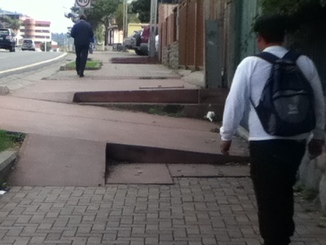 Common Courtesy This one is hard to describe, and I suspect has more to do with different cultural constructs around courtesy or politeness than any intentional rudeness. Yet we often experience the way Cuencans act as having a lack of common courtesy. For example, people walking four abreast on the walking path, and not adjusting their spacing so others can get past. Cars darting past each other, or into the lane that should be for oncoming traffic, just to get through the intersection faster. People crowding around the bus door to get on, no sense of line or order (although women with babies/toddlers and older people will often be given preference). Or the one that bothers me the most: I’ll be standing in a store waiting my turn for something (say to recharge a bus card, or get a copy made), and someone bursts into the store, and announces what they need. They get served, and I’m left waiting. At times I’ll take the more assertive route, but it is still a stretch for me. Pedestrian safety. Or lack thereof. The concept of pedestrian safety is codified in Ecuadoran laws, but doesn’t exist in any recognizable form in daily reality. Yes there are stop signs at intersections, but drivers respond to them by slowing just enough to look for oncoming cars (NOT pedestrians), and then proceeding. Yes, there are cross walks and modern walk signals, but they are taken as suggestions by both drivers and pedestrians. The most considerate driver might see a pedestrian and give a little honk to warn them to get out of the way. The fact that I can count on one hand the times that a car has actually stopped at a cross walk and waved me forward is telling. Drivers often consider the sidewalk an extension of the street. One day on my way to work I was honked at by a car so that I would move off the sidewalk and allow it to get to the corner. The driver was trying to get out of his driveway onto the street, but preferred to use the sidewalk rather than wait for an opening in traffic. The following picture was taken by our bus stop yesterday when a car conveniently pulled onto the sidewalk just as I was pondering how to get a picture of this common event. 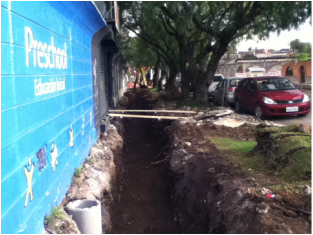 And then there are the sidewalks, littered with hazards. In addition to the aforementioned poop problem there is the fact that loops of rebar are routinely left sticking out of the sidewalk, and that garbage shelves on exterior walls hang above the sidewalk just at the height of a kid’s head. We’ve had no major incidents yet, but a fair number of stubbed toes. To its credit Cuenca is re-doing some of its sidewalks. In the neighborhood by the preschool they’ve replaced all the sidewalks and the new ones have curb cuts and are smooth. But I was flabbergasted by the lack of consideration for pedestrian safety during the renovation. Sidewalks on both sides of the street were torn up simultaneously, leaving no place safe to walk. A huge trench was dug in the sidewalks, and access to businesses, including our preschool, was provided by propping 3 wood planks over the 5-foot deep trench - no hand rails or other safety measures. Not exactly ideal for navigation by 2 -5 year olds. As striking as the lack of attention to safety is, it is more telling that Ecuadorians don’t seem to notice. I didn’t hear any parents complaining about navigating the planks in high heels with a toddler pulling on one arm, or about stepping out of the school gate at the end of the day and coming face to face with heavy machinery. Random annoying noises. I think I mentioned in an early post that the roosters start crowing very early. I have to admit that I hardly even hear the roosters anymore. We routinely hear car alarms, house alarms, and lots of honking. And of course dogs barking. When I complained to Doug yesterday that the extremely loud house alarm in the house across the street that was going off all morning he responded, “was it? I don’t even hear it anymore”. Maybe we’re adjusting, or maybe we’re going deaf. But on those days that the annoyances build on each other, the cacophony of alarms and barks can put us over the edge. Public Transportation. It is ironic that this is one of our top annoyances because we chose Cuenca in part because of its comprehensive and accessible public transportation system. And it is true, we can get just about anywhere on the bus at a very reasonable price (25 cents per adult, 12 cents a kid). The buses are even equipped with card readers, so we don’t have to carry cash), and audio/visual systems that announce the current and upcoming stop. The problem is that the bus rides can be so unpleasant that sometimes we avoid them altogether. It seems that the bus drivers are incentivized based on the speed with which they finish their route, and without any consideration for the passengers or any notion of customer service. The buses themselves seem to have chronic transmission issues (or maybe it is driver error), making for a very jolting ride. And popular routes are often so packed that bus drivers skip stops to avoid picking up more passengers. They will stop a block early to let passengers off, and then charge past the stop. When they stop it is more like a pause. Disembarking passengers must be ready at the exit door and jump off quickly to get clear of the bus before it proceeds. And when boarding one must be ready to brace oneself immediately or risk being thrown by a sudden jolt. I’ve opted to walk to work (a nice 25 minute start to the day, provided I don’t step in dog poop), rather than deal with the overcrowded buses, or the frustration of watching multiple buses zoom by the bus stop. We’ve learned to avoid the busiest times, and to choose routes based on bus occupancy rather than the most direct route. Lucia has adapted by mastering the Ecuadoran Taxi hail, sometimes hailing taxis without us approving. Luckily taxis are cheap (usually less than $2), although the quality of the driving and the availability of working seatbelts varies greatly. Specialized Shops Don’t get me wrong, I love the fact that there are mom and pop stores for everything in Ecuador, and that people are able to run their businesses on the lower level of their home. But for a family with two working adults, only one of whom feels fully comfortable in Spanish, this results in a lot of time spent seeking out the store where we can a particular item. For example: grass seed and sand for a school project; a pillow that offers a reasonable level of support; socks for an eight year old boy that don’t cost a fortune but will last more than a month; tennis shoes in a women’s size 8 ½, guitar strings, contact lense solution, etc. On a good day these errands provide a fun adventure, and a sense of accomplishment when achieved. On a bad day they take several hours, crammed in between work and dinner preparation, involve a crowded bus ride to a store location that has been vaguely described by a co-worker, and sometimes end in something less than success (yes we have the specialized paper required for your child’s school project, but only in the lined version, not the graph paper. Or sure, we have that size shoe but only in imported brands and at twice the price you’d pay at home). AAAAARG. En Fin Facebook and blog posts are more fun to create, and I suspect to read, when they celebrate things that are nice, beautiful, or exciting. Hopefully this post provides a bit of balance, and a peek into the less glamorous and sometimes very annoying side of our daily experience. I think it is safe to say we are getting what we hoped when it comes to experiencing the challenging as well as the beautiful aspects of residing in Ecuador. I’m a little sheepish about posting a Christmas- related post almost a month after the big day (or at least two weeks after, if you give us until Epiphany or 3 kings’ day). But this past Sunday we ran into yet another Christmas season procession (Pase del Niño), this one on the street in front of our house. It was no modest affair, involving several floats, many horses, elaborate costumes, strewn rose petals, and the ever present noise-making fireworks. I also just learned that the Pases go on until carnival, so I figure a Christmas post at the end of January isn’t too out of pace with Ecuadoran traditions. In my post on Christmas preparations I noted that the main focus here is on the Baby Jesus (El Niño), and the main event the Pase Del Niño, in which the faithful accompany the baby Jesus in a procession that ends with a mass in a church. We got to witness two impressive events related to the Pase Del Niño and live nativity scenes. El Niño Viajero On December 23 my sister Karin and I went to the flower market for centerpieces for our Christmas dinner, and happened upon the Pase for THE baby Jesus of Cuenca el Niño Viajero. The figure is called the Niño Viajero because it has traveled to many countries and to Rome where it was blessed by the pope. This Pase is short, just a couple of blocks from a very old church, by the flower market, and to the Cathedral on the main square. The procession included a few priests and nuns, a whole police/military detail, a horse mounted guard, and a number of officials, as well as an elaborate canopy to protect the figure of the baby during the procession. A helicopter buzzed overhead after the speeches that opened the event. Karin and I, our brains trained by our US experiences, assumed it was a news crew covering the big event. But no, the helicopter was there to drop thousands of fresh rose petals on the path of the procession, sweetening it for the Niño Viajero. It was quite something to watch all those petals drift down and to smell their fragrance in the air. Live Nativity Our church in Arvada has had a live nativity the last few years, and so it was fun to learn that Cuenca has live nativities also. Various communities participated in a live nativity contest on the central square, and we saw some really creative live nativities, one of which featured recycled materials in the costumes. Note in particular the use of recycled CDs as beautiful shiny objects in many of the nativity scenes and Christmas displays. El Pase del Niño de Cuenca On December 24 we watched part of the 5-hour procession in which many families and organizations participate to accompany various baby Jesus’. As you can see from the pictures, it was a pretty impressive event. Children dress up as shepherds and other biblical characters, girls wear long gowns that trail over the horses they are riding, floats display biblical scenes, meals featuring Cuy and other local delicacies, and participants are draped with abundant food and treasures. The other Pases del Niño we’ve seen have had similar participants and themes, but on a smaller scale. Nothing like Family The highlight of Christmas for the Faulkners was having the Gallups celebrate with us. The tradition in Cuenca is to have a turkey dinner at midnight on Christmas Eve, and open presents that night. But we opted for US traditions, in particular notes and treats left out for Santa in hopes that he would stop in Ecuador given that he seems to appear here only in certain households. (He did find us). And we opted for ham and tamales on Christmas Day as our celebratory meal, items we sometimes have at home. The tamales here are quite different than those we get in the US, though. They have a variety of vegetables inside as well as chicken or pork, hardboiled egg and a fig, are wrapped in savory leaves, and are served with Aji pepper sauce. We also bought an array of traditional sweets for dessert which made for a great picture, but otherwise were kind of a bust. Thank goodness the Gallups had brought some peppermint bark with them. The non-traditional parts of our Christmas day were a quick trip to some nearby hot springs for an enjoyable soak, and then packing for travels that began the morning of the 26th (teaser for future posts!). Twelve years ago when Doug and I were in Ecuador for our honeymoon we spent a few days in a small town with fantastic birding. We had wrongly assumed that there would be a bank or at least an ATM in town where we could get cash, but we were quite wrong. After a few nights in some very modest accommodation and eating frugally we were flat out of cash. Our only option was to contact a fancy eco-lodge that would glady take our credit card number over the phone, arrange for a driver to pick us up, and allow us to spend several nights in the expensive (but quite enjoyable) lodge. Thus we learned that if you want to spend big in Ecuador you can use your credit card, but otherwise you better have a lot of cash on you, however uncomfortable and/or unwise it feels. We had anticipated that we use a cash a lot more than credit cards in Ecuador, but we’ve still been surprised by the degree to which, 12 years later, our day to day transactions require cash. We only use our credit cards at the chain grocery store, and (rarely) at very expensive restaurants. Most hotels and lodges, except those serving international business travelers or the very rich, won’t take credit cards. Rent, utilities, school lunch fees and school bus fees are all paid in cash. It doesn’t make sense for us to have establish an Ecuadoran bank account for our short stay, but even people who have bank accounts conduct these same transactions in cash. For us this means planning cash withdrawls for big expenses a week or two in advance so that we can accumulate enough (given daily withdraw limits) to pay rent or other large quantities, like the deposit for our upcoming trip to the amazon. 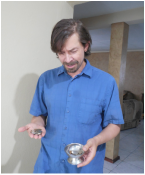 Petty Cash for Daily Transactions Given how much people rely on cash, it is amazing how no one ever seems to have change. At first we wondered why $1 coins are preferred over bills. Now we know it is because they are THE currency to have (everything seems to cost a dollar, or un dolarito), and because coins last so much longer than bills. Note: Ecuador’s currency is the US dollar, so we don’t have to worry about converting currency – just using it! A few examples of our experiences with the cash economy: *Taxi Drivers NEVER admit to having change… they’d rather round up, especially since the taxi meters calculate to the penny. Our change dish in the US was a way to get heavy coins out of our wallets. Now we frequently empty the dish into our wallets to be sure we’ve got appropriate taxi fare. Just as I was writing this post Doug began digging through the coin dish to get what he needed for a little excursion with the kids, and obliged with a slightly staged photo of our daily change management activity. * I mailed a letter from the main post office in Cuenca to the US, at the cost of $2.50. I had a $5 bill. Surely the main post office has change for a 5? Nope. The one employee on duty had to go over to the guy selling snacks in the corner to get change. * The bus fare machines don’t make change. People who don’t have exact change will pay what they have (Say 50 cents for the 25 cent fare) and then stand by the door and intercept the next person's quarter (politely) before it gets to the box. The bus drivers monitor this closely and help to make sure people get their change from the next people getting on the bus. * The man at the copy shop (I’ll have to talk about the huge number of photocopy/computer/internet shops and our frequent use of them in another post), would rather forgive me the 13 cents I owed him than have to make change for a dollar. The only folks who reliably seem to be able to make small change are the ladies at the market. Thank goodness for market ladies! You are giving me your what??? Is there no identity theft in Ecuador? Perhaps the most surprising thing about paying bills in Ecuador is that most bills are paid by making a cash deposit directly into another person’s bank account. This is how I pay our land lady, the woman who runs the lunch service at the school, and deposits for hotel reservations. I guess people are not worried about identity theft because to facilitate the transaction the payee provides their account number and their cedula, or state ID number (or passport number, in the case of foreign nationals who own hotels). Then I just walk into the bank, fill out a deposit slip, and put the money in their account. Usually the next step is making a copy of the receipt that then has to be given (or sent via email) to the person/business I just paid. Thus my 13 cent bill at the copy shop that I mentioned above. Have I mentioned that I really miss electronic banking?  Corte Inmediato: Paying Monthly Utility Bills: Shortly after we moved into our long-term rental a shut-off notice was taped to the door of our complex. It was for one of our neighbors, and I jumped to some conclusions about his bill paying habits. But then a few weeks later we got our own immediate shut-off notice, and I began to appreciate the complexity of the situation. The state runs the water and sewer, electric and telephone companies. Our rental house receives all of these services, but the accounts are all under different names (one for the current owner, two for the previous owner), because it is a hassle to change the name on accounts. The utility companies do not send out bills each month, but do charge a fee if the bills are not paid on time. How do you know what owe? Present in person to pay the bill…. The reason our water was threatened with shut-off is that when our landlord tried to pay our bill several weeks before we moved in, the reading had not been taken so the amount due was not known, so he could not pay it. Three weeks after we moved in, the payment was overdue, but no one knew (until the notice). Luckily our landlord was very responsive and quickly paid the bill. To pay the utilities one can go to stand in line at one of the big service centers with the appropriate cash. Or, one can pay through other authorized locations, like the little copy/internet/banking store close to our house (see picture below). Usually they are a small room with 3 computer stations, a printer, a scanner, and a cashier. These stores have accounts with the utility company, and will make payments for you electronically. Sometimes. Other times they are out of money in their accounts. Or there is a connection problem. So on the 27th go to this little store and they use a hand-held machine that looks like a credit card scanner. They spend 5 minutes punching in numbers, obtain the amount due in the account, and then make the payment for me, for which I pay them in cash. My understanding is that it is possible to make these payments with an electronic transfer if one has internet banking and the utilities are all in the appropriate name. But judging from the amount of use the service centers get, I don’t think many people take that route. It is an odd thing to celebrate a major holiday in a new cultural context. I’ve spent Christmas outside of the US before but that was before kids and without my own real living space, so I was content to observe and participate in others’ celebrations… I didn’t have to figure out how to celebrate as a family. This year we get the fun of learning about Cuencan and Ecuadoran traditions, and the challenge of figuring out how to make it “feel” like Christmas without the weather and trimmings that we usually enjoy. At home it “feels” like Christmas when the weather turns cold, the lights and trees are up, and we’ve pulled out our favorite decorations, advent calendars, Christmas books and music. Here in Cuenca the weather is pretty constant, so that cue is missing. And while Ecuadorans do put up Christmas trees, nativity scenes, and some lights inside their houses, they don’t drape blinking lights on every building (refreshing!), so the overall “feel” is different. Live Christmas trees aren’t really available here, and the artificial ones are expensive. And we don’t want to acquire a bunch of Christmas items that we would have to get rid of when we leave. So for inside the house we’ve come up with: a small nativity set I bought during the Fiestas of Cuenca; an advent calendar made out of toilet paper tubes, paint and tissue paper; paper ornaments made by the kids (still in process!); and a string of icicle lights made in, where else, China, that I splurged on ($7). We are planning to fashion a tree out of several large branches we found by the river, and we have a candle we’re using to mark the Sundays of Advent. What will really make it feel like Christmas is having the Gallups here to celebrate with – we can’t wait for that! Overall, I’m liking the minimalist approach, and the kids don’t seem to mind. They are signed up for a Christmas cookie baking class at a local bakery next Friday. I’m hoping Lucia will find some alternatives to the peppermint bark that she so wants to make…. And for which we cannot find peppermint candies! Meanwhile in Cuenca the main preparations involve the Nativity Scenes, Baby Jesus, and Christmas Baskets. Nativity Scenes: As in much of the Latin world, Ecuadorans have the tradition of putting up elaborate nativity scenes that represent not only the manger scene, but the whole family, village, etc. Many people have nativity scenes in their homes, and they personalize them to include their own family members or area. Businesses, institutions and markets also put up scenes. I’ve included some pictures of a big scene that is in the center of one of the main markets in Cuenca, right between the meat stands and the vegetable section, and another that is in an outdoor plaza. The big metallic scene seems very minimalist by comparison, but it lights up at night so I’m sure is quite impressive. Market stands sell little houses and figures that can be included in the scenes, some locally crafted and lovely and others imported and plastic. The scenes include depictions of traditional celebrations. You can even buy little ceramic roasted pigs and Cuyes, traditional dishes, to include in the scene. Here in Cuenca the scenes center around the elaborately dressed Christ Child, often seated in a chair. The Baby Jesus: Ecuador is a primarily Catholic country, and there is a very active devotion to the Christ Child. There are a number of shops where one can buy figures of the baby Jesus (carved wood or ceramic), and elaborate gowns and shoes for him to wear. This week tents have popped up in several squares where one can buy the baby and related adornments. (I was briefly tempted but wasn’t sure what we’d do in the US with a decked out baby Jesus, and I wasn’t willing to shell out $60-$100 for the whole deal). Throughout Advent there are veladas, devotions for the Baby Jesus, held in churches, followed the next day by a procession led by the baby Jesus. One of the biggest processions takes place in Cuenca on Christmas Eve and is called El Pase del Niño Viajero. All children are invited to join the parade, wearing traditional dress, angel’s wings, and other costumes. The figure of the baby Jesus that leads the procession was commissioned in 1823. It has traveled to various holy sites in the world, and been blessed by Pope John XXIII, thus the name Niño Viajero -Traveling Child. Baskets and Candy: It is a tradition in Cuenca for businesses/employers to give Christmas Baskets of food stuffs - Canastas Navideñas - to employees. I think the baskets are also sometimes exchanged among friends. In the past the baskets were assembled by hand and the baskets were woven baskets made near Cuenca. It seems now there is a trend toward pre-assembled “baskets” in cardboard. While families get baskets, kids get – what else- Candy! It is traditional at holiday parties for kids to get a “fundita de golosinas” – a little bag of candy. The local grocery stores have put up big displays where you can hand pick what goes into candy bags. You can also buy jumbo sized bags of candy and/or animal crackers to make up your own smaller bags. I managed to avoid being part of the PTA-like committee that organizes the parties for each of the grades at school, but there was plenty of discussion about the bags of candy, so it will be interesting to see what the kids come home with. We’re excited to experience Christmas in Cuenca, and will share what it is like in a future post. In the mean time, Feliz Navidad!
|
AuthorOur non-glamorous selves, living the daily Cuenca experience. Most posts are written by Elena, with editing and humor by Doug. The content, though, is inspired by all of our experiences. Archives
June 2015
Categories |
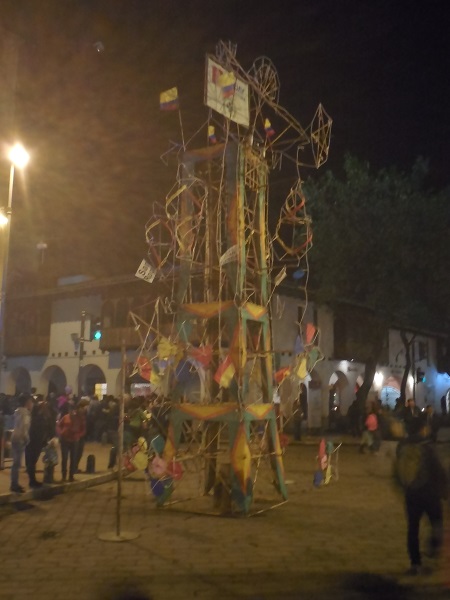

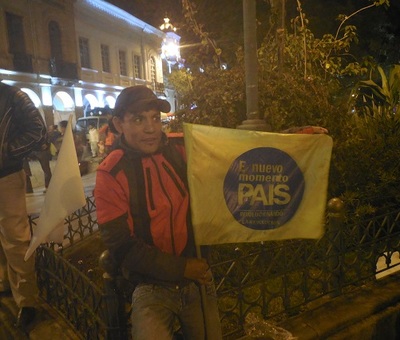
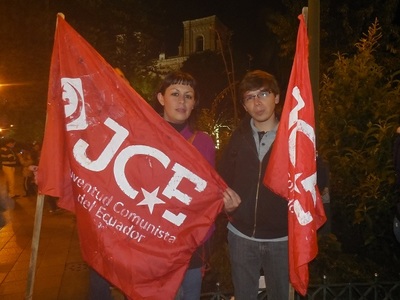
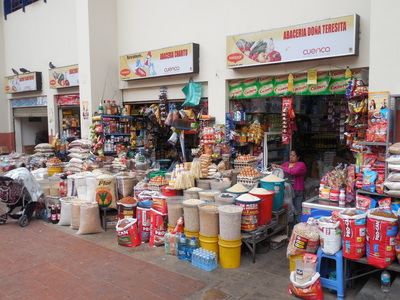
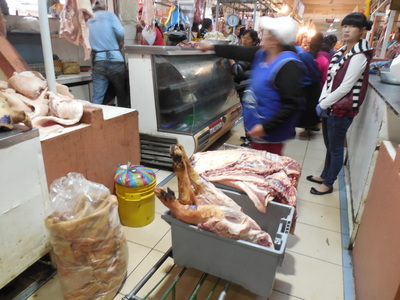
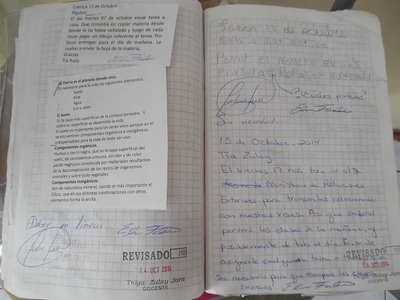
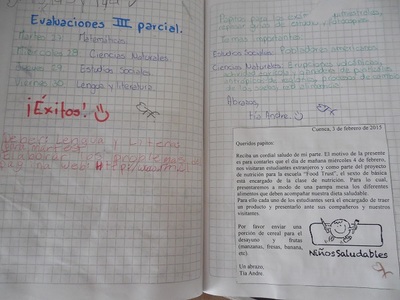
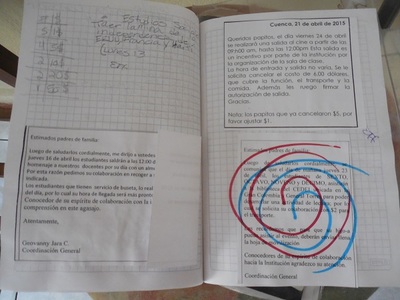

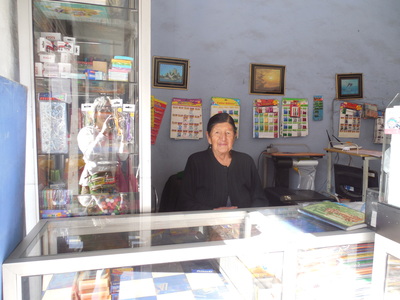

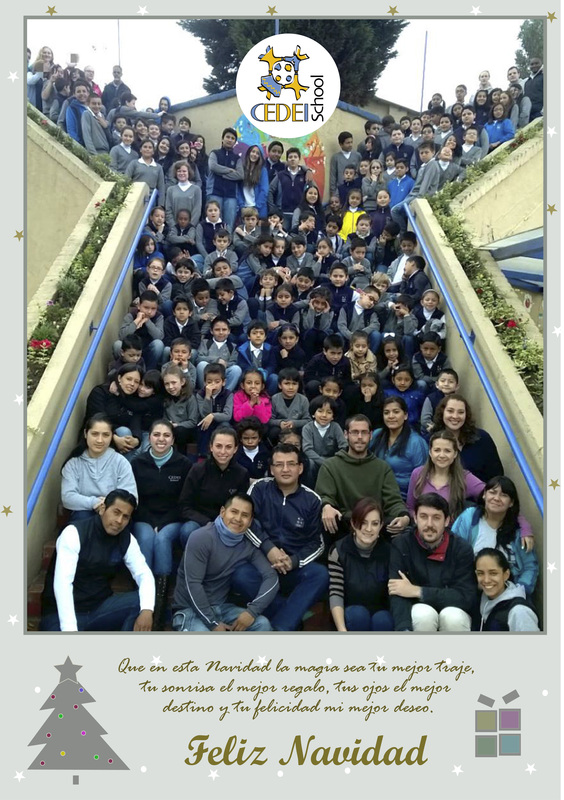
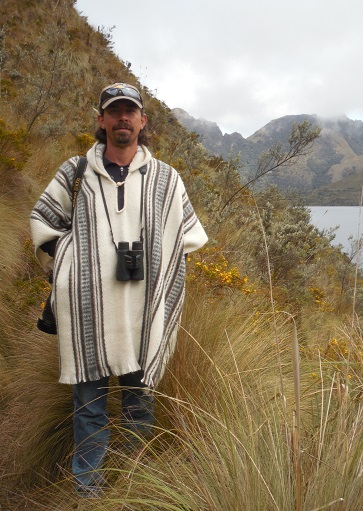
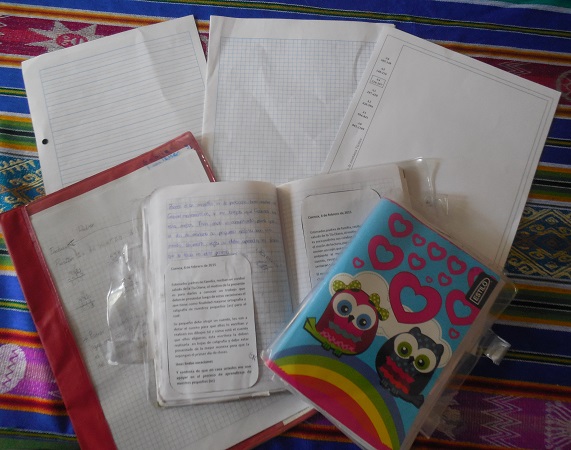
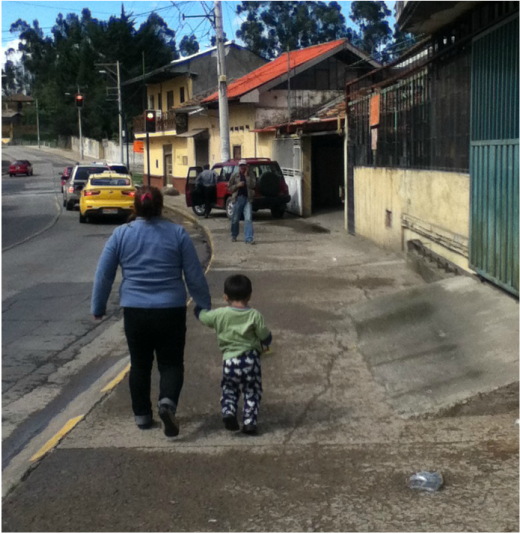
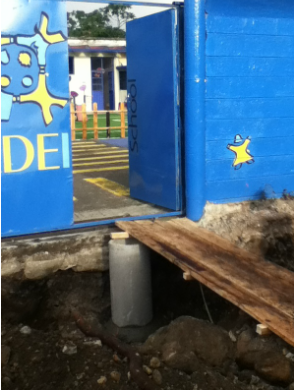
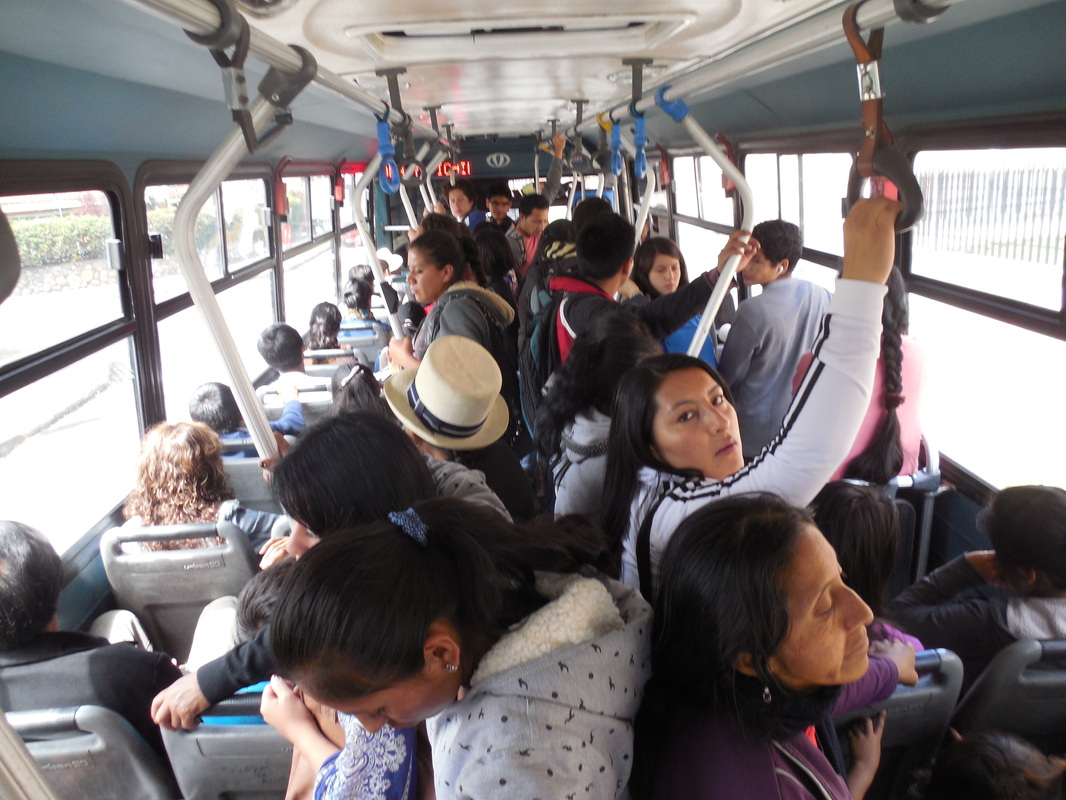
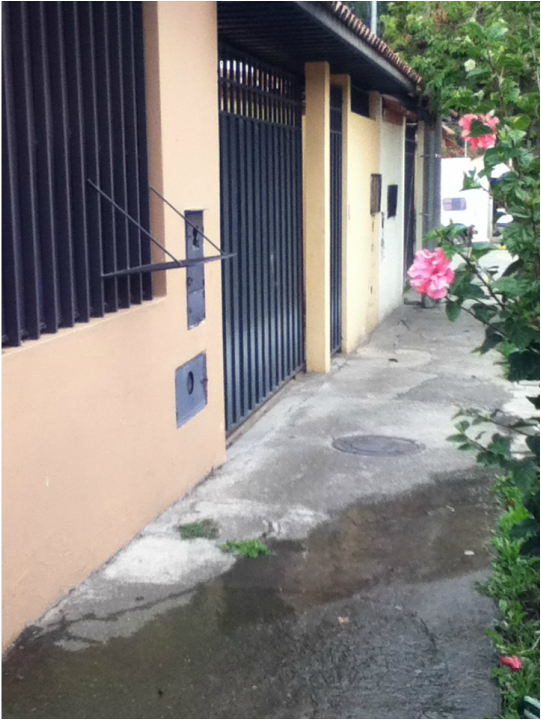
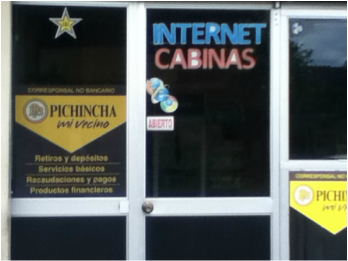
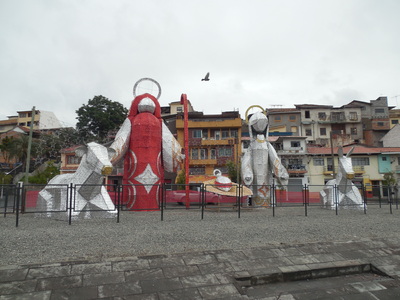

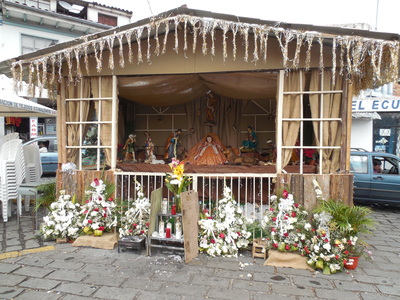

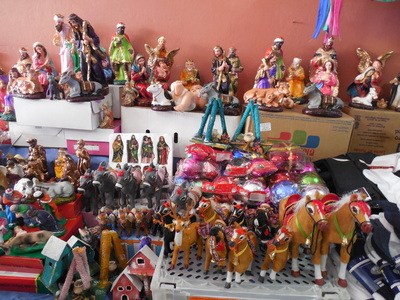
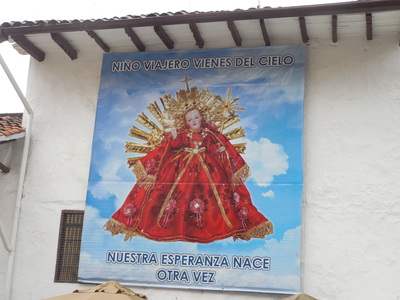
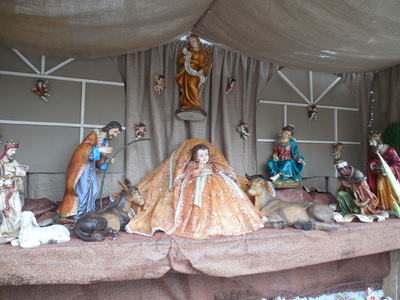
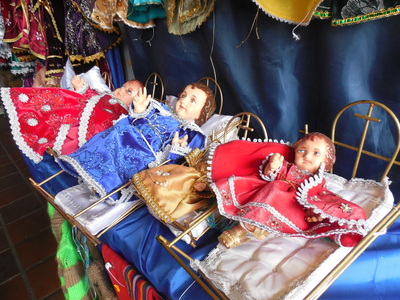
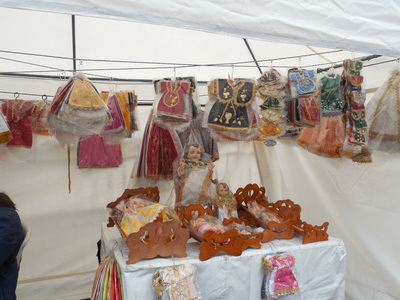

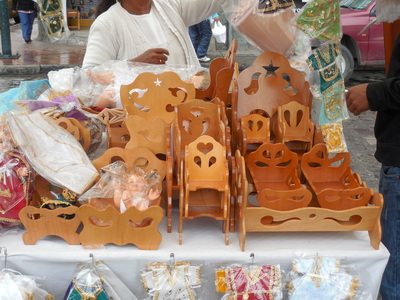

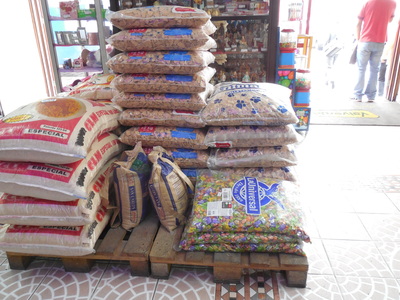
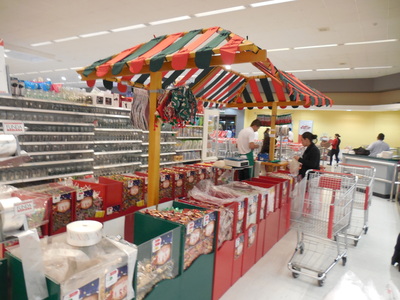
 RSS Feed
RSS Feed
